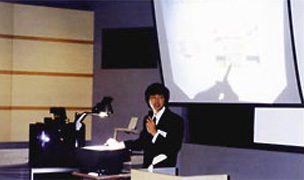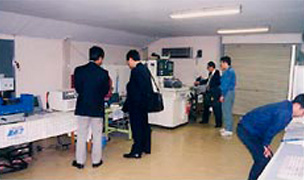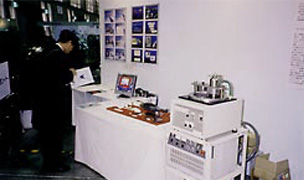Development
We are conducting series of research and development on precision and advanced machining technologies for plastic injection molds and pressing dies utilizing cutting edge machine-tools. And, we are cooperating with RIKEN and the related universities on new technology R&Ds which are promoted by microfabrication and ELID projects.
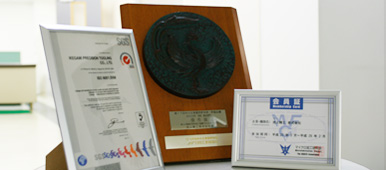
Snapshots in academic activities
Development of ELID Grinding Machine
We are developing desktop ELID grinding machines with advices from RIKEN.
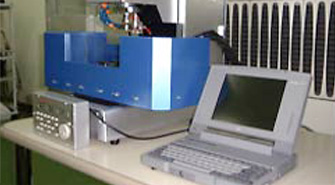
Desktop 3-axis mirror surface grinding machine
"鋭利刀™"
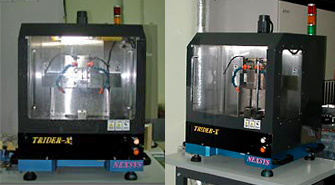
Desktop 4-axis mirror surface grinding/cutting machine
TRIDER-X™
This is a desktop mirror surface grinding/cutting machine with feed resolution of 0.2μm and the maximum feed speed of 3m/min, mounted with a high speed rotary table. Spherical and aspheric lenses and optical elements can be produced at high surface quality of nano-meter level.
Fundamentals of ELID-Grinding Principle
Ultimate Mirror Surface Finishing Technology*
What is ELID(Electrolytic In-process Dressing) Mirror Surface Grinding
Method?
The ELID (ELectrolytic In-process Dressing)-grinding is a mirror surface grinding method was invented by Prof.Ohmori at Materials Fabrication Laboratory of RIKEN (The Institute of Physical and Chemical Research). It is a new technique capable of highly efficient and high quality mirror-surface grinding for hard and difficult-to-grind functional materials such as silicon, ceramics, glass, ferrite, hard steel, composite materials, etc. The ELID-grinding method is applied to wide ranges of practical uses in precision manufacturing.
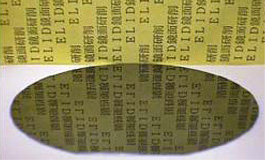
As shown in the figure, the conductive wheel (metal bond) serves as the positive electrode, and the negative electrode is installed opposite to the grinding surface of the wheel. The clearance between these two electrodes is set at 0.1 to 0.3 mm. D.C pulse voltage is supplied between the two electrodes to electrolytically remove only the metal bond of the wheel, allowing automatic dressing of the wheel. This dressing is continued even during the grinding work to prevent reduced wheel sharpness from wear, thereby realizing highly efficient mirror-surface grinding.
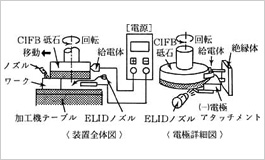
Dressing continues automatically during grinding. So, with conventional grinding methods, grinding efficiency drops when the wheel abrasives are worn out and the wheel becomes blunt. But by applying the ELID grinding method, wheel bluntness can be reduced.
Principle of ELID (Electrolytic In-process Dressing) Grinding Method
ELID stands for Electrolytic In-process Dressing. Its mechanism is explained as follows; first, as you can see at (1) in the figure below, the grinding wheel bond material is electrolyzed so that abrasives are protruded appropriately. This process at the same time produces metallic ions, which accumulates to form an insulating metal-oxide layer on the wheel surface, automatically reducing the electrolytic current. Initial dressing completes at this point (2). When the actual grinding work is started in this state, the insulating oxide layer on the wheel surface comes in contact with the surface of the workpiece, and is removed by friction. As this takes places, the abrasives start to grind the workpiece, and subsequently start to gradually wear (3). So this means that the insulation of the wheel surface decreases, and electrolytic current recovers. Also, the current starts flowing. As a result, electrolytic dressing starts again from the portions where the insulating layer has become thin between worn out abrasives (4). Abrasives also start to protrude (returns to (2) state).


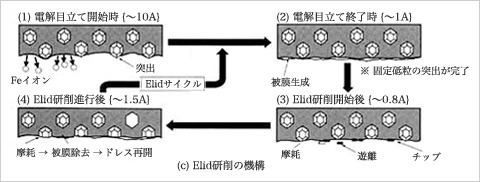
Mechanism of ELID (Electrolytic In-process Dressing) Grinding Method
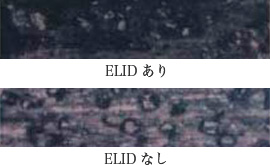
his flow is called "ELID cycle". Better grinding conditions which can realize high quality surfaces with efficiency are to be adjusted, although rate of ELID cycle differs according to metal bonds and electric and grinding conditions.
As the typical effects of ELID, the following photos show the surfaces of a grinding wheel after ELID-grinding (upper) and before ELID-grinding (lower) under a microscope. We can see that without ELID, abrasives wear out, and there are marks of scratching on the bond material by the workpiece, and this indicates that the grinding ability of the wheel has dropped. With ELID, the bond material surface is electrolyzed, maintaining protrusion of abrasives.
-
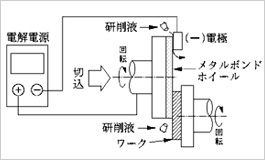
ELID can be used in variety of grinding types, such as reciprocating surface grinder, rotary grinder, cylindrical grinder, etc.
-
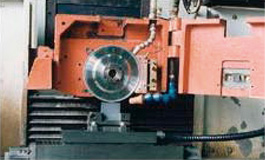
The representative ELID-grinders are shown.
This is a reciprocation surface grinder employed with ELID system. An ELID electrode is attached opposed to the grinding wheel surface and a brush in the wheel cover. Thus, the ELID-grinding can be realized. -
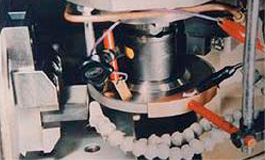
This is an example of a machining center with ELID system. An ELID electrode is attached opposed to the grinding wheel surface and a brush smoothly contacting the wheel body. Plunge grinding can be realized to highly efficient grinding with ELID.
-
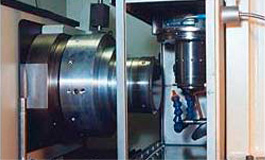
This is an example of aspheric generator with ELID system. An ELID electrode is attached opposed to the thin grinding wheel with radius in its edge and a brush smoothly contacting the wheel body. Ultraprecision aspheric machining can be realized.
※ Quotations of those explanations, figures, and pictures are allowed by ELID-Grinding Project. If you would like to reproduce them, you must be allowed also. ELID method is invented by Prof.Ohmori and is an intellectual property of RIKEN.
Contact
-
Microfabrication technologies
-
Ultraprecision machining technologies
Contact Us
Click here to contact us for information on our technology or for a quote.
- TEL:+81-52-823-2223(general inquiries)
- FAX:+81-52-821-5209
For those who require machining of a large variety of aluminum products in small quantities
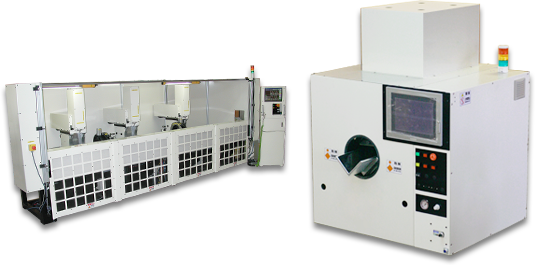
Sash-IN aluminum cutting machine:processing machine that does not require dies and molds
A factory tour and demonstration of machines in action are available.Please feel free to inquire.
